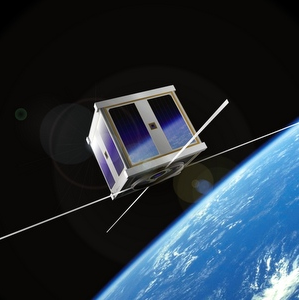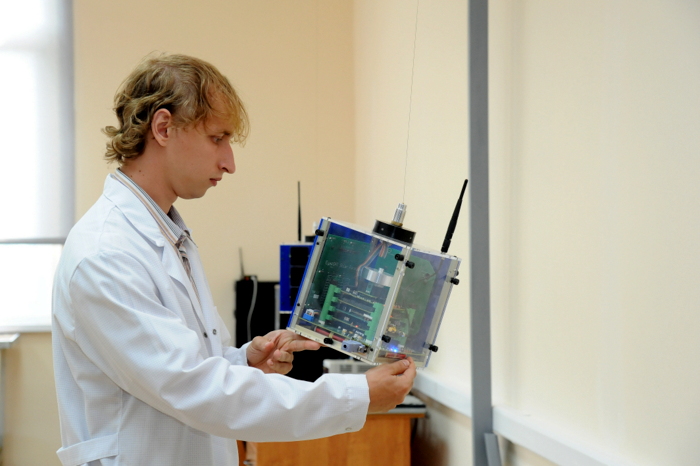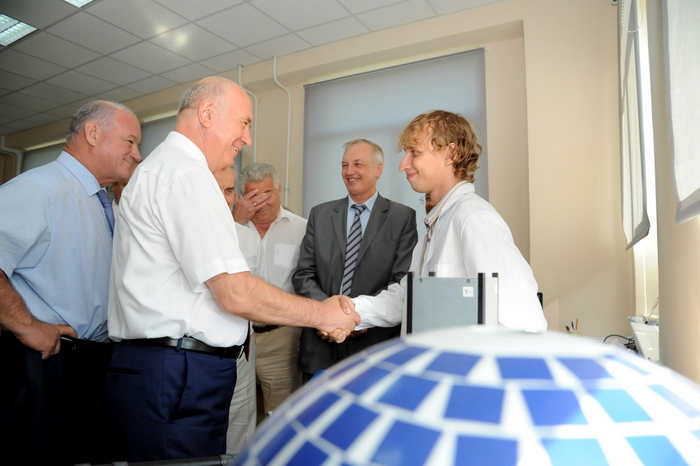
Scientists of Samara University (joined SSAU and SSU) began to develop a unified manoeuvring unit for CubeSat-type nanosatellites for the first time in Russia.
Its main feature is the small size and maintaining the full manoeuvring functionality. Dimensions of CubeSat-type nanosatellites typically do not exceed 10x10x30 cm. Therefore, standard solutions and elements used to create Russian space engines cannot be used here. And a group of Samara scientists working at the Interuniversity Department of Space Research solves the problem of manoeuvring unit creation almost “from scratch”.
Nevertheless, despite the small-size, it will be a complete space engine consisting of a reservoir with compressed gas under very high pressure, a control system, tube fitting, gas metering valve and a nozzle passage through which it is emitted. It is intended to use helium or nitrogen as a “working fluid”. Power mini-engine will be supplied by nanosatellite power system, it will also be controlled by on-board computer of the unit.
In addition, SSAU scientists initially make cross functional nanosatellite manoeuvring unit, having flexible mechanical and electrical interfaces. In the future it will allow equipping any CubeSat-type spacecraft with similar engine.
Creation of CubeSat-type nanosatellites by the world research and educational centres is a global trend. Samara University is a leader of this process in Russia. The new development brings the university to the international level.
“Creation of manoeuvring unit will allow us to reach the level of the leading aerospace universities in the world”, - says Professor Igor Belokonov, Head of the Department of Inter-University Space Research.
The use of such equipment greatly enhances the capability of nano-klass spacecraft. First of all, it concerns CubeSat groups solving specific tasks. Nanosatellites can scan the starry sky and, for example, to detect the asteroid hazard, maintaining a prescribed distance relative to each other by manoeuvring.
“Some applied and scientific problems can only be solved with the use of nanosatellites groups. For example, when you need to perform simultaneous measurements of the same type in different parts of the near-Earth space. It is impossible to do such work by one or several large units, but the group of nanosatellites is able to solve such a problem. Geophysical fields, Earth thermosphere and ionosphere may be studied in such a way,”- said Professor Igor Belokonov.
According to the applied astronautics it’s possible to perform effective inspection of the objects in space with the help of manoeuvring nanosatellites. For example, to remove a failed large spacecraft from the orbit first of all it’s necessary to know the characteristics of its motion dynamics. Ground means can do it only approximately. Nanosatellite is able to fly up to the large spacecraft, to take its photo, to assess the object motion - vibration or rotation, its angular speed and general condition. The obtained data can be used for the further disposal of the failed spacecraft and space debris removal from orbit.
The practical step to create the first Russian engine for CubeSat began thanks to Nikolay Merkushkin, the Governor of Samara Region. During one of his latest visits to SSAU he proposed to extend capability of the nanosatellites created in Samara University by making a manoeuvring unit and allocated funding to begin work on this topic. Innovation Fund of Samara Region began to finance this development since the end of 2015; the first prototype of manoeuvring unit for nanosatellite in Samara University will be made in middle of 2017.
For reference
Nanosatellites of Samara University
As a global trend, creation of CubeSat-type nanosatellites by the universities began to form in 1999 by California Polytechnic University and Stanford University. The first nanosatellite was launched into orbit in 2003.
The first Russian students’ CubeSat-type nanosatellite, developed by SSAU “SamSat-218” is currently at the space launcher complex Vostochniy and will be launched into orbit this spring as part of the first launch campaign from the new Russian space launcher complex by Samara rocket “Soyuz-2.1a” together with his “older brother” - Samara satellite “Aist-2D”.
The next SSAU project in this area is a nanosatellite SamSat-QB50 (the only one satellite from Russia) is preparing to participate in large-scale international project QB50 under the authority of Theodore Von Karman Institute for Fluid Dynamics (Belgium). The objective of the project QB50 is construction and study of the space-time model of the Earth thermosphere - the lower layers of the upper atmosphere.
The future plans of the scientists of Samara University are creation of CubeSat, equipped with a camera and able to solve problems of Earth monitoring.













